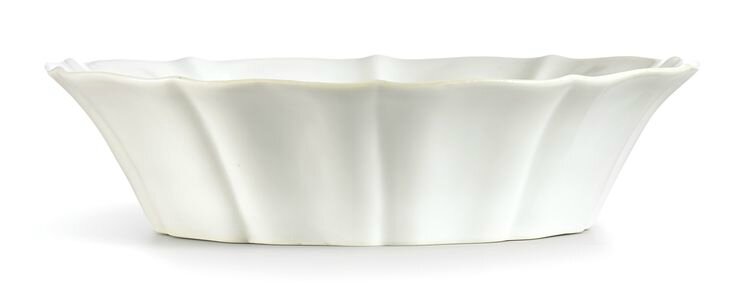A very rare white-glazed mallow-shaped washer, Mark and period of Zhengde (1506-1521)
A very rare white-glazed mallow-shaped washer, Mark and period of Zhengde (1506-1521); 19.3 cm., 7 1/2 in. Estimate 2,500,000 — 3,500,000 HKD (291,798 - 408,517 EUR). Unsold. Photo Sotheby's.
exquisitely potted with shallow flared sides gently divided into ten mallow petal-shaped lobes rising from a correspondingly shaped foot, covered overall with a glossy milky-white glaze with a faint bluish tinge, the domed base inscribed in underglaze blue with a four-character reign mark within a double-circle.
Provenance: Christie's Hong Kong, 30th October 2001, lot 612.
Greenwald Collection, inventory no. 80.
Christie's Hong Kong, 1st December 2010, lot 2807.
Notes: This charming piece is striking for its semi-translucent and glossy glaze, complemented by the elegant mallow shape. White glazed washers of this shape were first designed in the Yongle period (1403-24). Although no complete example appears to have been published, a reconstructed washer of this form and glaze was recovered from the Yongle stratum of the waste heaps at the imperial kiln site in Zhushan, Jingdezhen, and included in the exhibition Imperial Hongwu and Yongle Porcelain Excavated at Jingdezhen, Kaohsiung Museum of Fine Arts, Kaohsiung, 1996, cat. no. 100.
Zhengde mark and period washers of this form are held in important museums and private collections worldwide, including one in the National Palace Museum, Taipei, illustrated in Minji mehin zuroku [Illustrated catalogue of Ming dynasty porcelain in the National Palace Museum], vol. 2, Tokyo, 1977, pl. 104; another in the Museum of Far Eastern Antiquities, Stockholm, published in Jan Wirgin, Chinese Ceramics from the Axel and Nora Lundgren Bequest, Stockholm, 1978, pl. 44; and a third from the George Eumorfopoulos, Cunliffe and T.Y. Chao collections, sold in our London rooms in 1940, and twice in these rooms, 20th May 1980, lot 60, and 19th May 1987, lot 251. A further washer also from the George Eumorfopolous and Cunliffe collections and later in the Meiyintang collection, illustrated in Regina Krahl, Chinese Ceramics from the Meiyintang Collection, vol. 2, London, 1994, pl. 688, was sold in these rooms, 7th April 2011, lot 59; another from the collection of Nancy and Ira Koger, illustrated in Geng Baochang, Ming Qing ciqi jianding, Beijing, 1993, p. 116, pl. 216, was sold in our London rooms in 1986, in our New York rooms in 1990, and again in these rooms, 26th October 1993, lot 58; and two washers from the collection of Carl Kempe, published in Bo Gyllensvärd, Chinese Ceramics in the Carl Kempe Collection, Stockholm, 1964, pl. 687-8, were sold in our Paris rooms, 12th June 2008, lot 46 and 50.
Washers of this type appear to have been much treasured at the Qing court, as evidenced in the handscroll Guwan tu(‘Pictures of antiques’), dated in accordance with 1728, from the Sir Percival David collection and now in the British Museum, London, included in the exhibition China. The Three Emperors 1662-1795, Royal Academy of Arts, London, 2005, cat. no. 168, which includes a drawing of a closely related washer on a wooden stand.
Sotheby's. Important Chinese Art, Hong Kong, 07 oct. 2015, 02:30 PM

/https%3A%2F%2Fprofilepics.canalblog.com%2Fprofilepics%2F1%2F0%2F100183.jpg)
/https%3A%2F%2Fstorage.canalblog.com%2F03%2F02%2F119589%2F96711876_o.jpg)
/https%3A%2F%2Fstorage.canalblog.com%2F11%2F31%2F119589%2F94773502_o.jpg)
/https%3A%2F%2Fstorage.canalblog.com%2F20%2F83%2F119589%2F94772815_o.jpg)
/https%3A%2F%2Fstorage.canalblog.com%2F26%2F72%2F119589%2F75604929_o.jpg)
/https%3A%2F%2Fstorage.canalblog.com%2F59%2F60%2F119589%2F26458628_o.jpg)





/image%2F1371349%2F20240422%2Fob_9e242e_telechargement-8.jpg)
/image%2F1371349%2F20240422%2Fob_389183_telechargement-2.jpg)
/image%2F1371349%2F20240418%2Fob_ac5c4c_telechargement.jpg)
/image%2F1371349%2F20240418%2Fob_709b64_304-1.jpg)